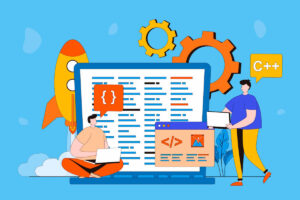From the foundational sockets to sophisticated server applications, PHP network programming stands as a vital component in web development. This blog post endeavors to unveil the mysteries of PHP network programming. It guides you through essentials like socket programming, handling streams, encrypting communication, and more. Understanding PHP’s capabilities in network programming is indispensable for developers looking to harness the full potential of the internet, with PHP playing a pivotal role in server-side scripting.
Understanding Network Programming
Network programming, in its essence, involves designing and implementing software that enables two or more devices to communicate over a network. This can range from basic data transfer to more complex interactions like remote procedure calls and managing network sessions. PHP, with its robust set of built-in functions and libraries for handling sockets and streams, provides developers with powerful tools to build networked applications. Additionally, PHP’s ease of integration with web technologies and its ability to handle HTTP requests and responses natively make it an excellent choice for developing server-side networking functionalities.
Setting Up the Environment
To venture into network programming with PHP, you’ll need a server environment capable of running PHP scripts and a client to test the server’s responses. Tools like XAMPP or MAMP can be effortlessly installed to set up a local server environment on your machine. These packages bundle PHP, MySQL, and Apache together, simplifying the installation and configuration process. After installing, developers should ensure their PHP installation includes extensions such as OpenSSL for encryption tasks.
PHP Socket Programming Fundamentals
Sockets in PHP serve as an interface for communicating between software, either within the same system or across different systems on a network. Essentially, sockets allow PHP scripts to interact with other applications over network protocols such as TCP/IP. This enables the development of diverse functionalities, from simple data exchange to complex web services. PHP’s socket programming capabilities are harnessed through its Socket extension, which provides a collection of functions to create, bind, listen, and close sockets, facilitating bi-directional communication.
Working with Streams in PHP
Streams in PHP abstract the process of reading from and writing to various sources like files, network resources, or data compressors. They are integral to PHP network programming, enabling developers to manipulate data streams consistently without concerning themselves with the underlying details. Additionally, PHP streams work with “wrappers,” defining the protocol to be used and providing a context for stream interactions. This further expands PHP’s flexibility in handling data.
Stream Contexts and Wrappers
PHP stream wrappers allow for operations on different types of data sources, like HTTP, FTP, or local files, using a unified interface. Stream contexts, created with the stream_context_create() function, give developers control over the parameters and options applicable to a particular stream. These contexts are pivotal when working with streams requiring specific configurations, such as HTTP headers or SSL encryption options.
Advanced Networking Concepts in PHP
Advanced PHP network programming involves techniques that enable more efficient and secure communication over networks. One such technique involves the use of non-blocking sockets, enabling a server to handle multiple connections simultaneously without waiting for operations to complete on any single connection.
This is vital for developing scalable applications that can serve many users.
Another crucial aspect of modern PHP network programming is encryption over networks, particularly through SSL/TLS for secure connections. These protocols ensure that data transmitted between clients and servers is encrypted, safeguarding against interception or tampering by unauthorized parties.
Building a Simple Client-Server Application in PHP
Step-by-Step Guide to Creating a Basic Client-Server Model
- Creating the Server: Begin by utilizing the
socket_create()function in PHP to create a server socket. Follow this by binding it to a specific address and port usingsocket_bind(), and then listen for incoming connections withsocket_listen(). - Handling Client Requests: Once a connection is established, the server can then read data sent by the client. This process involves reading from the socket and processing the request.
- Sending Responses: After processing the client’s request, the server can send a response back to the client through the same connection. This involves writing the response data to the socket.
- Implementing Non-Blocking Sockets: To make your server more scalable, implement non-blocking sockets. This will allow your server to handle other tasks or connections while waiting for data operations to be completed.
- Securing the Connection: Implement SSL/TLS encryption in your PHP application to secure data transmission over the network.
By following these steps, developers can create simple yet functional client-server applications, laying the foundation for more complex PHP network programming and PHP cloud computing projects.
Best Practices in PHP Network Programming
When developing network applications in PHP, it’s crucial to adhere to best practices, especially in areas concerning security, performance, and debugging. PHP network programming plays a vital role in the development ecosystem. It provides a robust platform for creating efficient and secure web applications.
Security Considerations
Security is paramount in PHP network programming. Developers should employ techniques such as input validation, output encoding, and the use of prepared statements to prevent SQL injection. Furthermore, ensuring PHP and its libraries remain up to date is essential for addressing security vulnerabilities as they arise.
Performance Optimization Tips
Performance optimization is another critical factor. Utilizing caching techniques, optimizing database queries, and implementing efficient data serialization and deserialization can significantly enhance the performance of PHP-based network applications. Profiling tools also help identify bottlenecks and optimize code execution.
Debugging and Troubleshooting Techniques
Effective debugging and troubleshooting are essential skills. Tools such as Xdebug for PHP provide valuable insights into code execution and performance, facilitating the identification and resolution of issues swiftly.
Future of PHP Network Programming
The future of PHP network programming is promising, with emerging trends and technologies shaping its evolution. The rise of IoT (Internet of Things) and real-time web applications highlights PHP’s potential role in processing and managing real-time data. Additionally, the advent of asynchronous programming in PHP, through frameworks such as Swoole, opens new avenues. These avenues facilitate the building of highly scalable network applications.
PHP network programming remains a dynamic and evolving field, essential for modern web application development. Developers can use PHP to create strong, efficient, and secure network applications by following best practices in security, performance, and debugging. Staying abreast of emerging trends is crucial in catering to an increasingly interconnected world.
Conclusion
PHP network programming offers a gateway to many possibilities in web application development. From managing sockets and streams to securing communication and exploring emerging trends, PHP provides the tools and functions necessary to craft sophisticated networked applications. This blog post outlined the critical aspects of PHP network programming, aiming to inspire and equip developers with the knowledge to excel in this domain. So, contact us today to get started on your PHP network programming journey!












+ There are no comments
Add yours